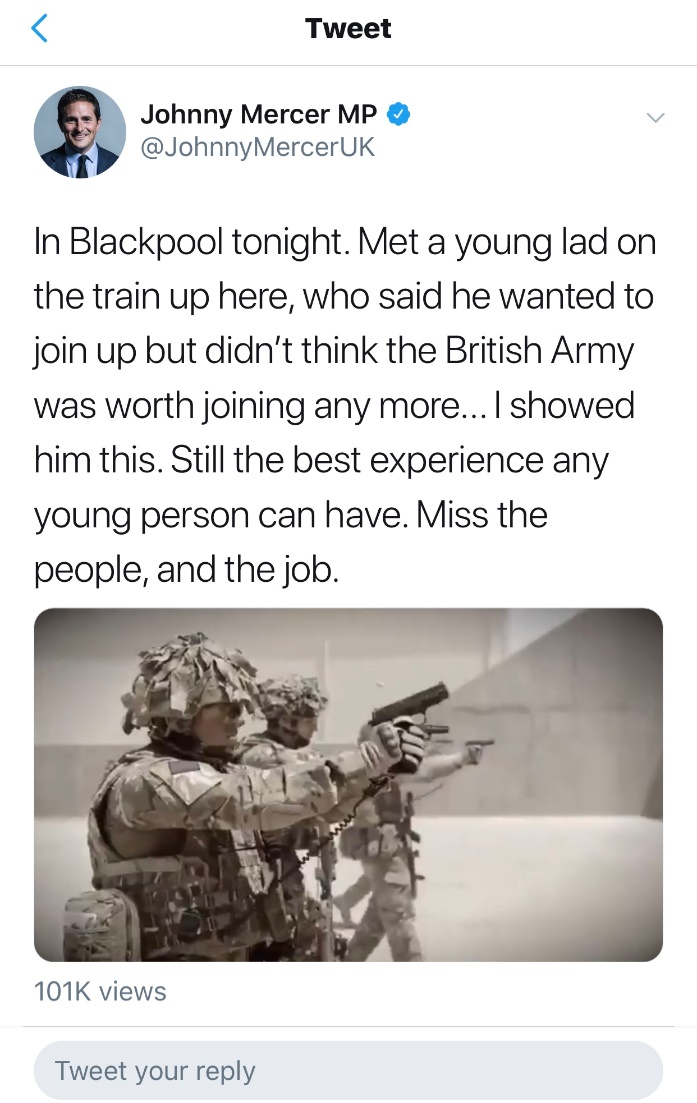Earlier this week I walked into a Twitter ambush. To be more precise, I stumbled unwittingly into a Twitter ambush of my own making. As the dust settles, I have taken some time to reflect on why events panned out the way they did and realised there are some important lessons to be learned. As with most things, context is everything: in this case it is a key component of understanding how events transpired. But the events are also instructive in showing how the Army fits into society within a modern context. As such, the lessons to be learned are both individual and organisational and I believe apply equally to the British and Australian armies, in both of which I have served.
Ambush set. It all started off so innocuously. I was packing up to leave the office and conducted a quick ‘Twitter Scan’ prior to jumping in the car. Within the feed was a tweet from Johnny Mercer, a former British Army officer who is now a Member of Parliament in the UK. It read:

The accompanying video was a professionally edited clip emphasising soldiers conducting high-end warfighting training. Frankly, it’s an excellent video and well worth a watch if you have not seen it. Importantly, it leaves the viewer with no disillusions that the role of the Army is the application of controlled violence against the nation’s enemies.
However, it struck me that the tweet had a greater meaning than that. Here was a member of the government, who happened to be a veteran, using social media to explain the role of the Army to a member of the public. It occurred to me that, just as the nature of war remains constant but its character changes, so the nature of Clausewitz’s second trinity – the government, the Army and the people – also remains constant, but their relationship and the manner in which they are connected has evolved over time.
This has been explored recently in professional military education articles, such as this one from The Strategy Bridge which argues that “Clausewitz’s translation of war’s nature onto the people, military, and government is being disrupted by emerging socio-political trends”. Yet in Mercer’s tweet we see a new avenue for connecting the three aspects of this trinity within the modern era: social media. In essence, in Mercer’s tweet I saw the C21st manifestation of a C19th military philosophy.
With this all flashing through my mind, I hastily constructed the following retweet:

Tweet sent, I jumped in the car and drove home, oblivious of both my typo and the electronic rounds already coming down range. I had entered the ambush killing area.
The response. The response was swift. One observer replied that 'You obviously have no idea about serving in the Armed Forces' and suggested that joining up might be a good idea as it would give me 'direction, discipline and a can do attitude', while another opened with 'I assume you have never been in the Forces'. This was followed up by another user who wrote, “So your military background is? You seem to have missed that very important part out. I look forward to being enlightened as to your operational experience”, while some further comments were so lewd as to be unrepeatable.
To be fair, there have been far more positive comments than negative, but if we are to continuously improve we need to recognise our failings and seek to address them. I have long held that when communicating any confusion lies at the feet of the person transmitting rather than the one receiving. As such, on reflection I believe the issue to be one of context, and it is an issue that needs addressing both individually and organisationally.
Individual context. It will come as little surprise that I am no Kim Kardashian or Taylor Swift when it comes to the number of Twitter followers I have. Those 900 odd people that do follow me are mainly either academics or commentators on Pacific issues (from my year’s sabbatical as a Research Fellow at the Lowy Institute), or military officers who follow me as the Director of The Cove, the Australian Army’s online professional military education portal. Thus, for my own followers, my tweet pondering the evolution of Clausewitz’s theory would have either been read and dismissed as rather boring (Pacific watchers) or read and understood in its own context by most of the followers of The Cove.
However, by responding to Johnny Mercer’s tweet I suddenly opened up the target audience to over 42,000 people who follow the MP, many of whom are probably unaware of Clausewitz or his second trinity, but quite of few of whom who have served in the British Army. Thus, my assumption of the target audience was flawed and the language I used confused and alienated people. For some, this confusion meant they took my comments to be an attack on the British Army. As a recent Wavell Room article on communications pointed out, it is important to 'Know your targets: who are you communicating with and why?' In this case I had neglected to realise that the ‘target’ for my tweet had changed.
It is also important for users to remember that for professional military education to be of any use, it must be accessible to all. Therefore, the overall platform of delivery must be considered for appropriateness: as one kind observer pointed out, Twitter is not the greatest medium for the conveyance of tone. For complex issues such as the one I was addressing, an article such as this, or perhaps a Facebook post, is probably more appropriate than trying to abbreviate the meaning you are trying to convey to 250 characters.
Organisational context. There is also an organisational context and one which I believe needs addressing in both the British and Australian armies. There appears to be a growing view among both serving soldiers and veterans (exemplified by some of the comments above) that unless you have worn a uniform there is no way in which you can usefully contribute to the debate. Indeed, some seem to hold the view that those who have not served should not comment on the Army or on military matters under any circumstance.
This seems to be a part of a widening divide between the military and the civil society it both recruits from and serves. In the UK, the adoption of the armed forces covenant into law (a policy being proposed by the current Australian government) turned an unspoken convention, whereby the nation looked after those who served in the armed forces, into an act of parliament that de facto ensures the members of the armed forces and veterans are categorised as a separate entity to the rest of society. It is quite right that the nation looks after those injured or wounded, including mentally, during their service and such schemes are to be fully supported and expanded wherever possible. The importance of ensuring soldiers and their families are not disadvantaged through their service is obvious: the discounts from businesses for individuals who have chosen a career in the armed forces less so.
The proposed introduction of Veteran’s Cards and discounts for veterans serve to quietly reinforce the perception that those who have served are somehow separate from the society they are both recruited from and to which they return when they leave the military. As can be seen with the backlash over Virgin Australia’s short-lived proposal to let military personnel and veterans board flights first, this only serves to undermine popular support of the military among the wider population. Indeed, as Australian veteran Roger Shanahan observed, there are many members of society, such as emergency responders, who are just as worthy of recognition.
Both the British and Australian armies need to address this growing perception of uniqueness, particularly when it comes to professional military education and commenting on the role of the Army in society. A rifleman who served for four years, including a tour of Helmand or Uruzghan province, will have a very practical view of the Army. However, to argue that their view is more valid than, for example, Sir John Keegan’s or Eliot Cohen’s just because the latter have not served in the Army is potentially dangerous, for to do so denies the input of people who have spent their lives studying the army and military-civil relations respectively. The key here is that both those who have served, and those who have not, have valid roles to play in developing military thought as long as their views are taken in context.
Avoiding the next ambush. Social media provides a useful tool for those promoting professional military education as well as those engaged with wider society, particularly if myths around soldiering are to be dispelled. However, it is important that it is used wisely. Target audiences must be carefully matched with delivery platforms and accessible language. It is the role of individuals to understand the context in which they are operating before they engage with the wider public.
However, organisationally the British and Australian armies need to also examine the context of their relationships with civil society. The armies of liberal democracies recruit from society, serve society, and return their soldiers to society on retirement. Policies, no matter how well intentioned, that promote an attitude of exceptionalism from society not only undermine civil-military relations, but diminish the breadth of experience available to develop the intellectual component of fighting power. Anecdotally at least, this appears to be a growing problem. It is the responsibility of all commanders, regardless of rank or position, to guard against this happening through open and honest engagement with their soldiers about the Army's role in society, for it is the foundations set while serving that will influence life-long attitudes.









